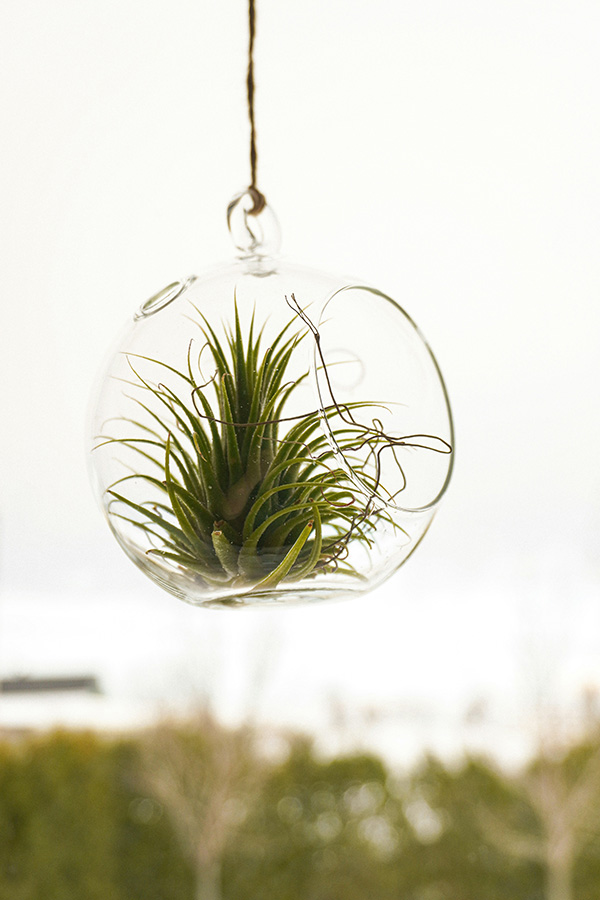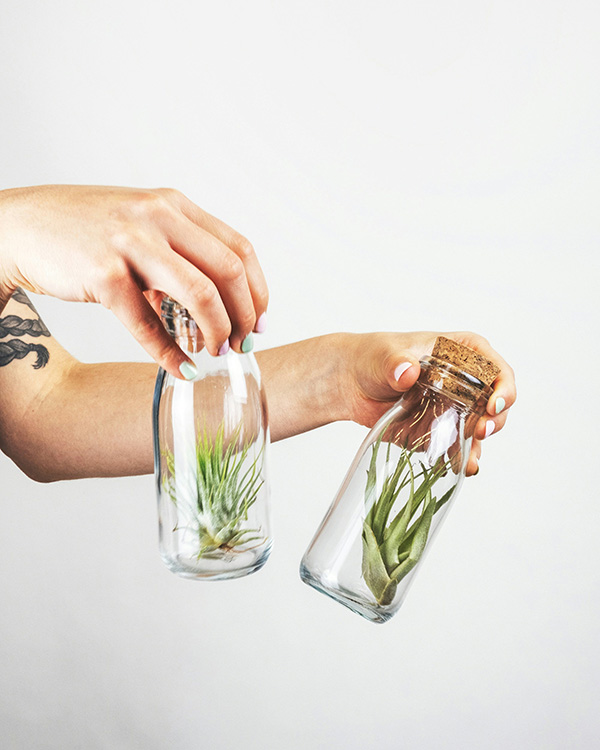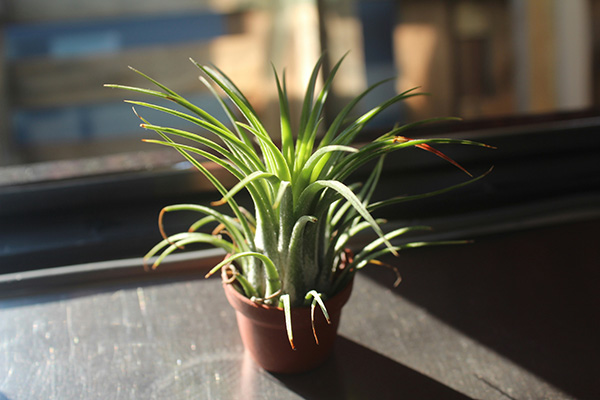In the world of houseplants, few specimens are captivated by their whimsical charm as much as air plants are. Scientifically identified as Tillandsia, these enchanting plants have become well-liked for their distinctive capacity to flourish without soil. Despite their delicate appearance, the resilience and adaptability of air plants render them a captivating inclusion in any indoor garden.
In this guide, we'll dive into how to care for air plants and some air plant care tips so they can flourish in your home. From sharing the requirements of growing air plants to propagating air plants, we will share everything you need to know.
What Are Air Plants?
Air plants, scientifically known as Tillandsias, are a group of epiphytic plants that hail from diverse regions of the Americas, spanning from the southern United States and Mexico to Central and South America. What distinguishes them is their exceptional capacity to flourish without the requirement for soil, leading to the moniker "air plants." Originating primarily from tropical rainforests, deserts, and mountains, air plants have adapted to cling to trees, rocks, and other surfaces, drawing nutrients and moisture from the air. Their care is characterized by minimalism; they thrive in bright, indirect light, require occasional misting or soaking to quench their thirst, and can add a touch of botanical intrigue to any space.

Common Varieties
Tillandsia Ionantha: Tillandsia Ionanthas are petite air plants, typically measuring around 2-3 inches in height. They form compact rosettes with vibrant green leaves. During their blooming phase, their leaves undergo a stunning transformation, turning fiery shades of red or orange, creating a captivating contrast.
Tillandsia Xerographica: Xerographicas are known for their medium to large size, often reaching lengths of 10 inches or more. They are true sculptural wonders with silvery-gray, twisting leaves that gracefully curl and contort. Their unique form makes them stand out as captivating centerpieces.
Tillandsia Bulbosa: Bulbosa air plants are typically small to medium-sized, ranging from 4 to 6 inches in height. They are distinctive with a bulbous base and curly, tendril-like leaves that can vary in color, ranging from lush green to reddish tones.
Tillandsia Caput-Medusae: Caput-medusae air plants are medium-sized, typically measuring between 4 to 6 inches. They resemble the wild locks of Medusa with their curling, twisting leaves. Their unique appearance can display shades of green and even turn reddish-purple, making them an intriguing addition to any collection.
Tillandsia Brachycaulos: Brachycaulos air plants are small to medium, generally reaching heights of 3 to 5 inches. They showcase brilliant green leaves that undergo a breathtaking transformation during their blooming phase, turning fiery red or orange and creating a stunning visual contrast.
Tillandsia Stricta: Strictas are typically small to medium-sized, ranging from 3 to 5 inches in height. They form dense rosettes with slender, bright green leaves. Their leaves may take on a subtle blush of color in optimal conditions, adding to their aesthetic appeal.
Tillandsia Harrisii: Harrisii air plants are small, measuring around 2 to 3 inches. They are characterized by their delicate, thin leaves that form a tight rosette. As they mature, their leaves develop a beautiful silvery hue.
Tillandsia Usneoides (Spanish Moss): The size of Spanish Moss varies significantly, with long, trailing strands that can extend several feet. Resembling wispy, silvery-green threads hanging from trees, Spanish Moss creates an ethereal, curtain-like effect in its natural habitat.
Tillandsia Juncea: Juncea air plants are small to medium-sized, typically measuring around 4 to 6 inches. They feature long, slender leaves that often take on a reddish tint, lending them a graceful and elegant appearance.
Tillandsia Abdita: Abdita air plants are small, usually around 2 to 3 inches in height. They form compact rosettes with bright green leaves. During their bloom cycle, their leaves blush with shades of pink or red, adding a vibrant pop of color to your collection.

Air Plant Care Requirements
Light
Air plants thrive in bright, indirect light conditions, mimicking their native habitats, clinging to trees and rocks beneath the canopy. Most air plant species grow in shady canopies of trees. Ensuring their vitality involves situating them near a window with filtered sunlight or supplying artificial light sources, such as fluorescent or grow lights.
Steer clear of subjecting them to intense, direct sunlight, which can result in leaf burn. Striking the right balance between light and shade is the key to nurturing these resilient botanical companions, allowing them to flourish and grace your indoor space with their unique charm.
Water
Air plants can be tricky to water due to their unique physiology. These plants lack a traditional root system and absorb moisture through tiny leaf trichomes. Overwatering can lead to rot, as they are sensitive to excess moisture. Conversely, underwatering can cause dehydration. Striking the right balance by misting or submerging them appropriately is crucial for their health, making their watering requirements distinct from typical potted plants.
When watering air plants, the frequency and choice of water play critical roles in their well-being. While it may seem counterintuitive, air plants generally prefer less frequent watering compared to traditional potted plants.
Air plants are adapted to extract moisture from the air, and their unique physiology allows them to thrive with less frequent watering. A common practice is to mist them with a spray bottle every one to two weeks. Alternatively, immerse them in a water container for approximately 30 minutes. However, it's crucial to ensure that excess water is shaken off and the plants can dry thoroughly, preferably upside-down.
One of the key considerations for air plant care is the choice of water, and rainwater is often recommended for several reasons. Firstly, rainwater is naturally pure and lacks the chemicals commonly found in tap water, such as chlorine and fluoride, which can be absorbed by air plant trichomes (small hair-like structures on their leaves) and potentially harm the plant over time.
Secondly, rainwater is generally softer than tap water, indicating a lower mineral content. Air plants are sensitive to mineral buildup, which can clog their trichomes and hinder their ability to absorb nutrients and moisture. Rainwater's softness reduces this risk.
Also, rainwater tends to have a neutral pH, closer to the ideal pH range for air plants. Tap water may have fluctuating pH levels, which might not be ideal for these plants.
Lastly, rainwater can contain trace minerals and nutrients from which air plants can benefit. While air plants don't require frequent fertilization, rainwater provides a natural source of these elements. Collecting rainwater for your air plants or using purified or filtered water to mimic its qualities can contribute to their overall health and vitality in your indoor space.
While rainwater is preferred, you can water air plants with tap water. Tap water often contains minerals, such as chlorine and fluoride, which can accumulate on the plant's leaves over time. If tap water must be used, let it sit for 24 hours to allow chlorine to dissipate before applying it to your air plants.
Temperature
Indoor cultivation of air plants comes with specific temperature considerations to ensure their well-being. Air plants belonging to the Tillandsia genus generally thrive in temperatures between 50°F and 90°F (10 °C to 32 °C). Maintaining this temperature range is crucial for their well-being. Although they can endure occasional temperature fluctuations, avoiding prolonged exposure to extreme cold or heat is advisable. Air plants are resilient, but their ideal temperature range allows them to flourish without stress.
Humidity
Indoor air plant cultivation entails specific considerations regarding humidity levels. Air plants, members of the Tillandsia genus, thrive in environments with moderate humidity, ideally ranging from 40% to 60%. Maintaining adequate humidity is vital for their well-being, as they draw moisture from the air through tiny trichomes on their leaves.
In excessively dry indoor conditions, providing occasional misting can help supplement humidity. Conversely, overly damp surroundings can lead to issues like rot. Striking a balance by monitoring humidity levels and ensuring adequate air circulation is key to nurturing these resilient botanical companions, allowing them to thrive in your indoor space.
Fertilization
Air plants can thrive without frequent fertilization. However, providing a gentle nutrient boost can benefit their growth. A diluted, water-soluble, balanced fertilizer with a ratio of 10-10-10 applied once a month during the growing season is sufficient. Steering clear of over-fertilization is essential, as it can potentially harm these resilient plants. Striking a balance between minimal and occasional fertilization ensures that air plants receive the nutrients they need without overburdening them, contributing to indoor health and vitality.
Propagation
Cultivating air plants indoors offers a distinctive opportunity for plant enthusiasts to propagate and expand their botanical collections. Air plant propagation methods are refreshingly simple and primarily revolve around the natural formation of offsets, often referred to as "pups." These pups are essentially miniature versions of the mother plant and typically grow around the base of a mature air plant.
To propagate air plants successfully, one needs to wait patiently until these pups reach a reasonable size, typically about one-third to one-half the size of the mother plant. At this stage, they are ready for separation. During this process, caution should be exercised to prevent damage to the pup or the parent plant.
Once the pups are gently separated from the mother plant, they should be left to air-dry for a few hours. This crucial step helps prevent rotting when the pups are placed in their new location.
After the drying period, the propagated pups can be situated in their new homes, whether that's in a separate container, attached to a decorative piece, or incorporated into an existing air plant arrangement.

Common Problems and Troubleshoots
Overwatering
Overwatering air plants is a common pitfall that can lead to brown or blackened leaves that feel mushy to the touch. To resolve this problem, allowing the plant to dry thoroughly after each watering is essential. Adjust the watering schedule to ensure excess moisture doesn't accumulate around the plant's base. Proper drying between waterings is key to preventing overwatering-related problems.
Underwatering
When air plants don't receive enough hydration, their leaves can become wrinkled or curled, giving the appearance of dehydration. To tackle this problem, enhance the frequency of watering. Ensure the plant receives adequate moisture to maintain its turgidity and overall health.
Rot
Rot is a serious concern and is evident by a foul odor and dark, mushy spots on the plant. To combat rot, carefully trim away the affected areas using clean, sharp scissors or shears. Additionally, it improves air circulation around the plant and ensures it dries completely between waterings. This helps prevent the conditions conducive to rot.
Improper Light
Air plants may suffer if exposed to improper lighting conditions. Symptoms include fading or browning of leaves. To address this issue, modify the plant's placement to ensure it receives the appropriate amount of light. Typically, air plants flourish in bright, indirect light and should be protected from direct sunlight.
Nutrient Deficiency
Slow growth and a lack of vibrancy may indicate a nutrient deficiency. To remedy this, offer the plant occasional diluted fertilizer during the growing season. This will supply the essential nutrients for healthy growth without overburdening the plant.
Pests
Pests like aphids or mealybugs can infest air plants, leading to various issues. To combat pests, gently spray the affected plant with soapy water to remove the insects. Sustain a clean environment to deter reinfestation and conduct regular inspections of your plants for any indications of unwelcome visitors.
Temperature Stress
Temperature stress can manifest as discolored leaves or the development of dry spots. To mitigate this issue, ensure that your air plant is situated within the recommended temperature range for its species. Safeguard the plant from extreme cold or heat, as exposure to such conditions can induce stress and contribute to health issues.
Improper Display
Sometimes, air plants may not thrive in their chosen display method. Troubleshoot this by adjusting the display to suit the plant's needs better. Guarantee sufficient air circulation around the plant and offer proper support if needed. An appropriately chosen display method improves the plant's overall health and appearance.
FAQs
How To Tell If Air Plants Need Water?
Signs of dehydration include wrinkled or curling leaves, a dull or lackluster appearance, brown leaf tips, tilting or drooping, and slowed growth. Dehydrated air plants may have shriveled, limp leaves, and their overall vibrancy diminishes.
To check for hydration, gently squeeze the base of the plant; if it feels soft and squishy, it needs water. Proper hydration results in turgid, plump leaves, vibrant colors, and consistent growth. Maintaining a balanced watering schedule, ensuring proper drying after watering, and monitoring the plant's appearance are essential to prevent dehydration and promote the health of air plants.
How To Tell If Air Plants Get Perfectly Hydrated?
Signs of appropriately hydrated air plants include turgid, firm leaves, vibrant green colors, and regular growth. When squeezed gently at the base, a well-hydrated air plant should feel plump and firm. It should maintain an upright, healthy appearance without drooping or curling leaves. Adequately hydrated air plants exhibit steady growth, producing new leaves and, in some cases, even flowers.
Can you save over-watered air plants?
Saving an overwatered air plant requires swift action and care. Begin by removing excess moisture: gently shake or tap the plant to dislodge water from its base and leaves.
Next, position the air plant in a well-ventilated area to enable it to dry thoroughly, a process that may take several hours to a day. Trim any rotting or discolored parts with clean scissors. Modify your watering schedule to prevent potential overwatering, making sure the plant dries out completely between watering sessions.
